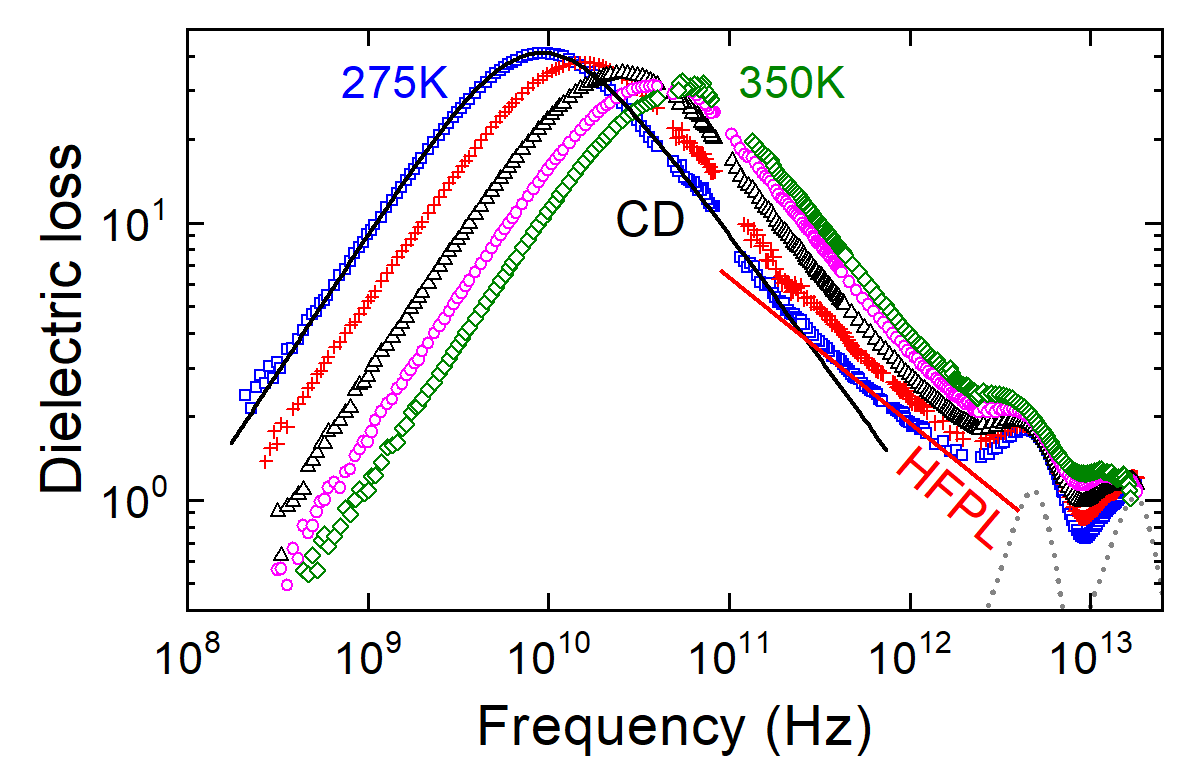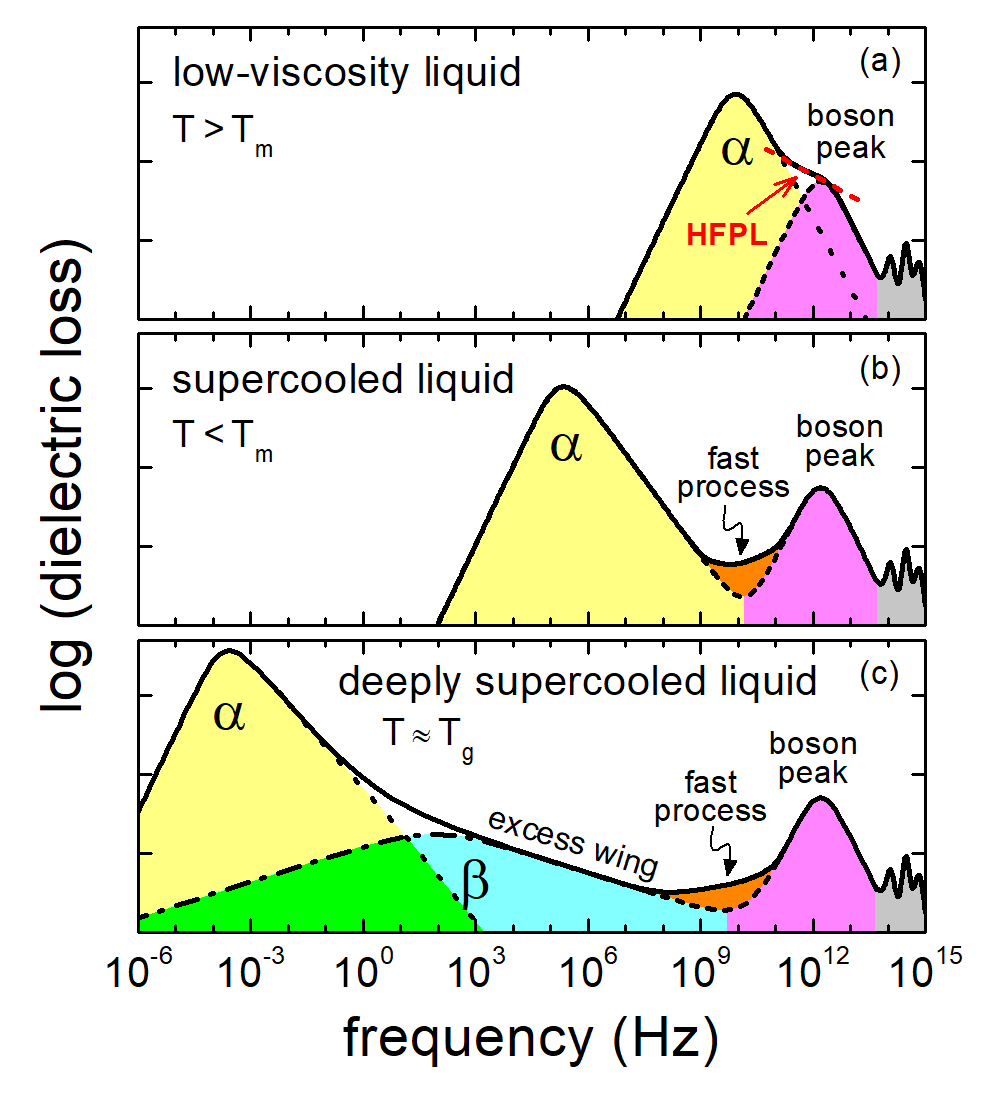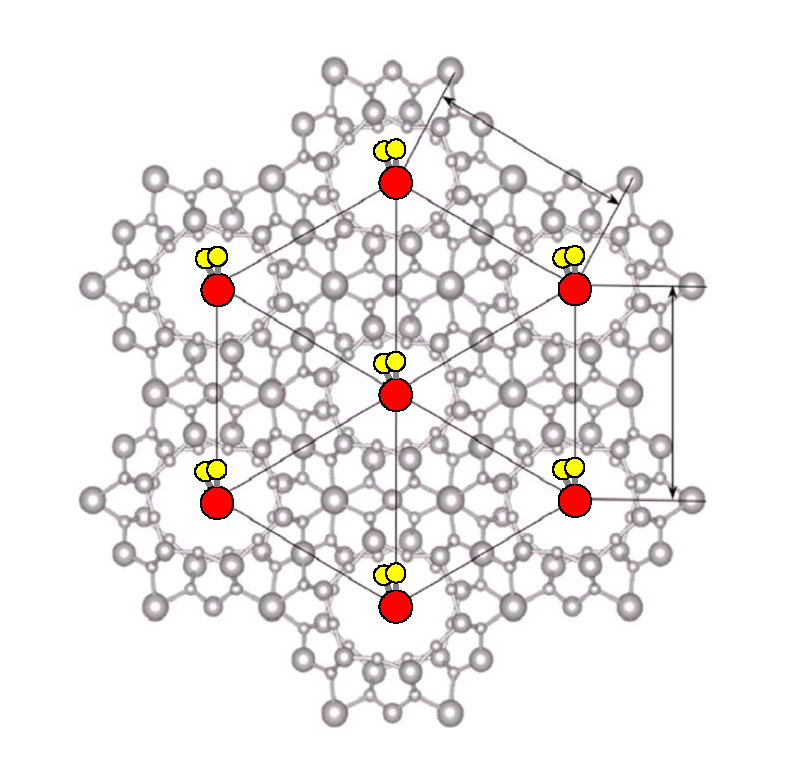WATER

WATER |

|
1. Introduction
It is quite self-evident that water is an extremely important material. Nevertheless, many of its unusual physical properties are not well understood. Some of them are addressed in our research:
2. Examples
a) Electromagnetic-radiation absorption and dynamic processes of water
By combining dielectric, microwave, THz and far-infrared spectroscopy, we have investigated the temperature-dependent dielectric properties of water in an exceptionally broad frequency range [5]. Amongst others, these properties determine the absorption of electromagnetic waves which is relevant, e.g., for microwave heating, airport body scanners or the biological effects of mobile-phone radiation. Moreover, our measurements help to clarify the microscopic origin of the different, often controversially discussed absorption modes of water, revealed in broadband dielectric-loss spectra.
By comparison with results on aqueous salt solutions and other dipolar liquids, we find that water s dielectric properties are not unusual but should be interpreted along similar lines. Especially, we found that the controversially discussed high-frequency power law (HFPL) of water, observed around THz frequencies, is caused by the so-called boson peak, universally detected in dipolar liquids. In water around room temperature, it is simply strongly superimposed by the α-relaxation peak and only shows up as a power law.

|
Dielectric-loss spectra of water at selected temperatures. For 275K, the black line indicates the
α relaxation, which can be described by the Cole-Davidson function, just as for most
other dipolar liquids.
The red line indicates the controversially discussed high-frequency power law (HFPL).
At the highest frequencies, two vibration-related high-frequency resonances show up.
[after: P. Lunkenheimer, S. Emmert, R. Gulich, M. Köhler, M. Wolf, M. Schwab, and A. Loidl, Electromagnetic-radiation absorption by water, Phys. Rev. E 96, 062607 (2017).] |

|
Schematic illustration of broadband dielectric-loss spectra in
glass-forming dipolar liquids.
(a) Low-viscosity liquid at high temperatures. (b) Supercooled liquid below the melting point
Tm but still far above the glass-transition temperature Tg. (c) Supercooled-liquid regime close to Tg.
The contributions from the different dynamic contributions are: The
α-relaxation,
the Johari-Goldstein β-relaxation (leading to an
excess wing
in the present example),
the fast process, the boson peak and intramolecular resonances at the highest frequencies. For water around room
temperature, case (a) applies and the superimposed α and boson peaks lead to an apparent HFPL.
[after: P. Lunkenheimer and A. Loidl, Glassy dynamics: From millihertz to terahertz, The scaling of relaxation processes, eds. F. Kremer and A. Loidl (Springer, Cham, 2018), p. 23.] |
|
P. Lunkenheimer, S. Emmert, R. Gulich, M. Köhler, M. Wolf, M. Schwab, and A. Loidl, Phys. Rev. E 96, 062607 (2017). |
b) The glass transition of water in confinement
One of the most important unresolved questions concerning water is its glass transition and a suggested closely related liquid-to-liquid transition (termed "fragile-strong" transition). Unfortunately, both are predicted to occur within the so-called "no-man's land" between about 150 and 235 K, where inevitable crystallization of bulk water prevents the investigation of these phenomena. However, when confining water in nanometer-sized pores, crystallization in this region can be avoided. Usually, such experiments suffer from ill-defined pores and pore-wall effects. We have investigated the glass transition of water confined in a metal-organic framework with well-defined 3-dimensional pores and very hydrophobic pore walls, strongly minimizing these problems [6].
We find that in confinement, a different type of non-bulk water is formed, nevertheless still undergoing a glass transition. Interestingly, two different length scales seem to exist in water: A smaller one (~2nm) is the cooperativity length scale governing glassy freezing. A larger one (>2nm) characterizes the minimum size of the hydrogen-bonded network needed to create "real" water with its unique dynamic properties.

|
Arrhenius plot of the relaxation times of confined and bulk water.
There is a crossover from stronger to weaker temperature dependence revealed within the no-man's land with decreasing T
(at 1000/T ~ 5.7K-1). It arises, because here the growing length scale of cooperative molecule-motions
starts to exceed the pore size of ~2 nm. Notably, it does not reflect the fragile-strong transition suggested for bulk water. [τ of supercooled bulk water taken from Bertolini et al., J. Chem. Phys. 76 3285 (1982); τ of bulk low-density liquid water at T<150K from Amann-Winkel et al., PNAS 110, 17720 (2013).] [after: J.K.H. Fischer, P. Sippel, D. Denysenko, P. Lunkenheimer, D. Volkmer, and A Loidl, Supercooled water confined in a metal-organic framework, Commun. Phys. 3, 95 (2020).] |
For further details, see:
J.K.H. Fischer, P. Sippel, D. Denysenko, P. Lunkenheimer, D. Volkmer, and A Loidl,
Commun. Phys. 3, 95 (2020).
c) Water in proteins
Proteins contain so-called hydration water within a shell close to the protein surface which plays an important role for their functional and physical properties. Dielectric spectroscopy can detect the motions of the hydration-water molecules which is important to learn more about the protein functionality. It also can reveal information on the enigmatic glass transition of water because hydration water does not crystallize, enabling measurements within the so-called no-man's land of water (see point b, above). By measuring aqueous protein solutions [3], we have investigated many different aspects of protein dynamics like the tumbling motions of the protein molecules, the glass transition of proteins and the water-protein interaction.
Protein solutions exhibit numerous intramolecular motions and solvent interactions, giving rise to many superimposed relaxation processes complicating the interpretation of their dielectric spectra [3] (see upper part of the figure below). To investigate the hydration-water dynamics, one can circumvent such problems by measuring frozen protein solutions, where many of these processes are frozen out (lower part of figure) [4]. In this way, we have proven the existence of slow and fast hydration-water dynamics due to strongly and loosely bound water, respectively. For the latter, we have found clear indications of a strong-fragile transition, whose possible occurrence in bulk water is very controversial.

|
Schematic plot of the dielectric loss of protein solutions above (a) and below (b) the freezing point of water.
Circles: loss after subtraction of the dc conductivity and electrode (EP) contributions. Many processes
vanish in the frozen state (b), making the evaluation easier.
Observed processes: β- and γ-relaxations: reorientations of the protein and free water molecules, respectively; sub-β: conformational sampling; δ: hydration water; "ice": Proton hopping in ice. [from: M. Wolf, S. Emmert, R. Gulich, P. Lunkenheimer, and A. Loidl, Dynamics of protein hydration water, Phys. Rev. E 92, 032727 (2015).] |
For further details, see:
Dynamics of protein hydration water
M. Wolf, S. Emmert, R. Gulich, P. Lunkenheimer, and A. Loidl,
Phys. Rev. E 92, 032727 (2015).
d) Dielectric ordering of water molecules
Together with scientists from Moscow, Novosibirsk, Prague and Stuttgart, we have solved the long-standing question whether the dipolar water molecules can spontaneously order parallel, thus forming a ferroelectric state [7,8]. Such an exotic state of water is thought to be of high relevance in various natural systems and also might enable future applications in biocompatible nanoelectronics. In a joint experimental effort, we could show that separate H2O molecules, enclosed within nanosized channels in a crystal of the beryl family, indeed can form such a state, revealing the typical signatures of ferroelectrics in the dielectric properties.

|
Schematic plot of ordered water molecules within cordierite nanopores.
[after: M.A. Belyanchikov et al., Dielectric ordering of water molecules arranged in a dipolar lattice, Nat. Commun. 11, 3927 (2020).] |
For further details, see:
Dielectric ordering of water molecules arranged in a dipolar lattice
M.A. Belyanchikov et al.,
Nat. Commun. 11, 3927 (2020).
[PDF]
3. Some relevant publications from our group:
| [1] | Dielectric spectroscopy on aqueous electrolytic solutions R. Gulich, M. Köhler, P. Lunkenheimer, and A. Loidl, Radiat. Environ. Biophys. 48, 107 (2009). |
| [2] | Broadband dielectric spectroscopy on human blood M. Wolf, R. Gulich, P. Lunkenheimer, and A. Loidl, Biochim. Biophys. Acta. 1810, 727 (2011). |
| [3] | Relaxation dynamics of a protein solution investigated by dielectric spectroscopy M. Wolf, R. Gulich, P. Lunkenheimer, and A. Loidl, Biochim. Biophys. Acta. 1824, 723 (2012). |
| [4] | Dynamics of protein hydration water M. Wolf, S. Emmert, R. Gulich, P. Lunkenheimer, and A. Loidl, Phys. Rev. E 92, 032727 (2015). [PDF] |
| [5] | Electromagnetic-radiation absorption by water P. Lunkenheimer, S. Emmert, R. Gulich, M. Köhler, M. Wolf, M. Schwab, and A. Loidl, Phys. Rev. E 96, 062607 (2017). [PDF] |
| [6] | Supercooled water confined in a metal-organic framework J.K.H. Fischer, P. Sippel, D. Denysenko, P. Lunkenheimer, D. Volkmer, and A Loidl, Commun. Phys. 3, 95 (2020). [PDF] |
| [7] | Dielectric ordering of water molecules arranged in a dipolar lattice M.A. Belyanchikov et al., Nat. Commun. 11, 3927 (2020). [PDF] |
| [8] | Single-particle and collective excitations of polar water molecules confined in nano-pores within
cordierite crystal lattice M.A. Belyanchikov et al., Phys. Chem. Chem. Phys. 24, 6890 (2022). |
| [9] | 2H NMR studies on the dynamics of supercooled water in a metal organic framework V. Schiller, K. Knippen, A. Loidl, P. Lunkenheimer, D. Volkmer, and M. Vogel, J. Chem. Phys. 159, 034501 (2023). |
| [10] | Exploring water's no-man's land P. Lunkenheimer, D. Reuter, A. Schulz, M. Wolf, and A. Loidl, Phys. Rev. E 111, 065408 (2025). [PDF] |